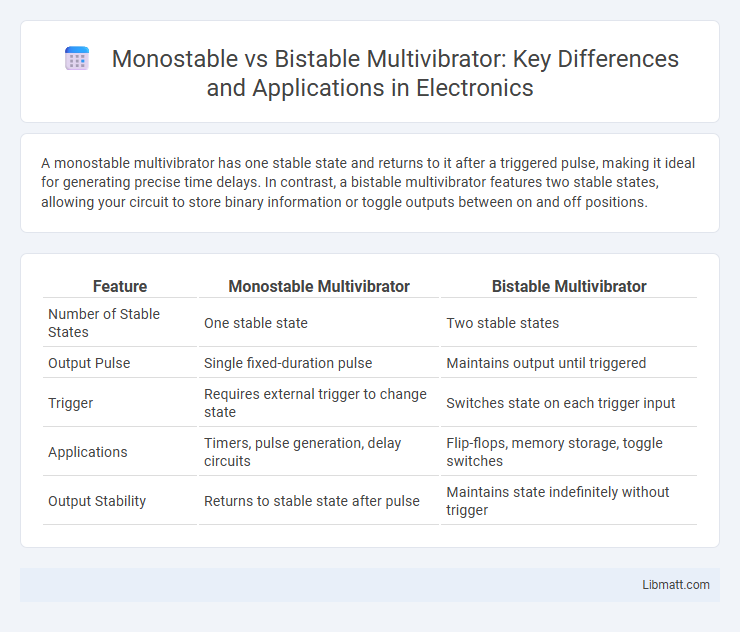A monostable multivibrator has one stable state and returns to it after a triggered pulse, making it ideal for generating precise time delays. In contrast, a bistable multivibrator features two stable states, allowing your circuit to store binary information or toggle outputs between on and off positions.
Table of Comparison
| Feature | Monostable Multivibrator | Bistable Multivibrator |
|---|---|---|
| Number of Stable States | One stable state | Two stable states |
| Output Pulse | Single fixed-duration pulse | Maintains output until triggered |
| Trigger | Requires external trigger to change state | Switches state on each trigger input |
| Applications | Timers, pulse generation, delay circuits | Flip-flops, memory storage, toggle switches |
| Output Stability | Returns to stable state after pulse | Maintains state indefinitely without trigger |
Introduction to Multivibrators
Multivibrators are fundamental electronic circuits used to implement various timing and waveform generation functions, with monostable and bistable types serving distinct roles. A monostable multivibrator generates a single output pulse of fixed duration in response to a trigger, making it ideal for timing applications and pulse shaping. In contrast, a bistable multivibrator, or flip-flop, maintains one of two stable output states until an external trigger causes it to switch, providing essential functionality for memory storage and switching circuits.
What is a Monostable Multivibrator?
A Monostable Multivibrator, also known as a one-shot pulse generator, produces a single output pulse of fixed duration in response to an input trigger. It has one stable state and one unstable state, returning to the stable state automatically after the pulse time expires. Common applications include timers, pulse width modulation, and debounce circuits in digital electronics.
Key Features of Monostable Multivibrators
Monostable multivibrators generate a single output pulse of fixed duration in response to an input trigger, making them ideal for timing and pulse-width modulation applications. They feature one stable state and return to this state automatically after the pulse duration, providing precise and repeatable timing intervals. Your choice of a monostable multivibrator ensures reliable single-shot pulse generation for use in timers, delay circuits, and waveform shaping.
Applications of Monostable Circuits
Monostable multivibrators are widely used in timing applications such as pulse generation, delay circuits, and switch debouncing because they produce a single output pulse of a defined duration in response to an input trigger. These circuits are essential in digital systems for one-shot pulse generation, timer circuits, and frequency dividers. Their use in precise timing control makes them ideal for applications like pulse-width modulation and measurement instruments.
What is a Bistable Multivibrator?
A bistable multivibrator is an electronic circuit that has two stable output states and can switch between them when triggered by an input signal. It is commonly used for storing binary information, functioning as a basic flip-flop in digital electronics. This device maintains its state indefinitely until an external trigger changes it, making it essential for memory storage and switch debouncing applications.
Key Features of Bistable Multivibrators
Bistable multivibrators have two stable states, allowing them to store binary information as flip-flops in digital circuits. Their key features include the ability to maintain output state indefinitely until an external trigger forces a switch, making them ideal for memory storage and switch debouncing. You can use bistable multivibrators for applications requiring stable on/off control, such as data latching and toggling circuits.
Applications of Bistable Circuits
Bistable multivibrators, also known as flip-flops, are widely used in digital electronics for memory storage, data synchronization, and switching applications due to their two stable states. These circuits serve essential roles in registers, counters, and frequency division, enabling reliable binary state retention and signal stabilization. Bistable circuits are fundamental components in sequential logic systems, digital clocks, and pulse generation for timing control.
Monostable vs Bistable: Core Differences
Monostable multivibrators have one stable state and generate a single output pulse when triggered, returning to the stable state after the pulse duration. Bistable multivibrators maintain two stable states, allowing them to switch and store the output until the next triggering event. The core difference lies in monostable devices being pulse generators, while bistable devices function as flip-flops or memory elements.
Advantages and Limitations of Each Type
Monostable multivibrators offer precise pulse generation with a single stable state, making them ideal for timing applications and pulse width modulation, but they require external triggering and have limited pulse duration control. Bistable multivibrators feature two stable states allowing for reliable memory storage and switch debouncing, yet they can be more susceptible to noise and require careful threshold setting for stable operation. Both types serve distinct functions in digital circuits, with monostables excelling in transient pulse generation while bistables are preferred for state retention and switching.
How to Choose Between Monostable and Bistable Multivibrators
Choosing between monostable and bistable multivibrators depends on the desired circuit function; monostable multivibrators generate a single output pulse of fixed duration in response to an input trigger, ideal for timing applications and pulse shaping. Bistable multivibrators, or flip-flops, maintain a stable output state until an input signal causes a switch, making them suitable for memory storage, toggling, and switch debouncing. Evaluate the need for a temporary pulse versus a stable on/off state to select the appropriate multivibrator type for your electronic design.
Monostable vs Bistable multivibrator Infographic

 libmatt.com
libmatt.com